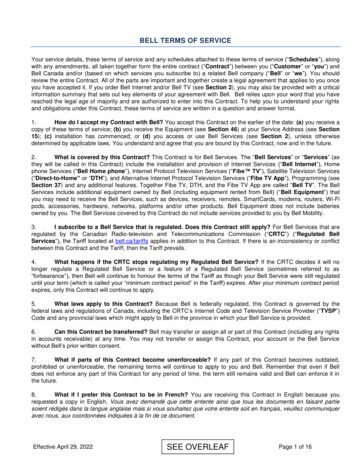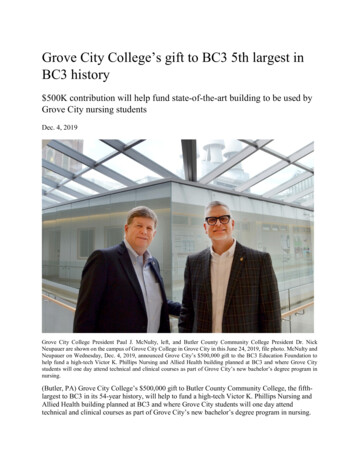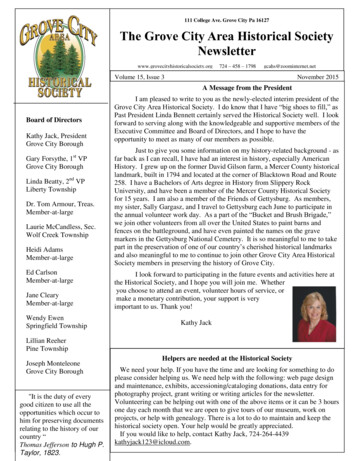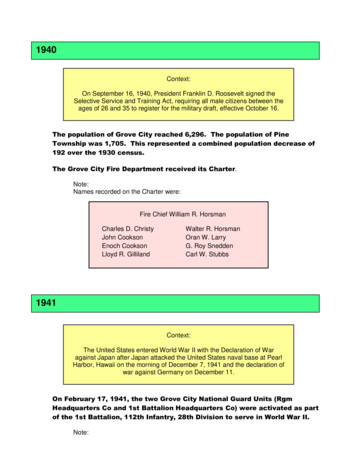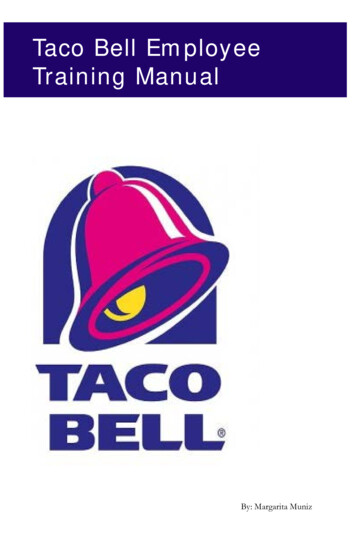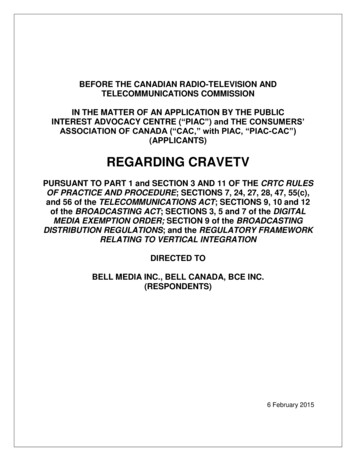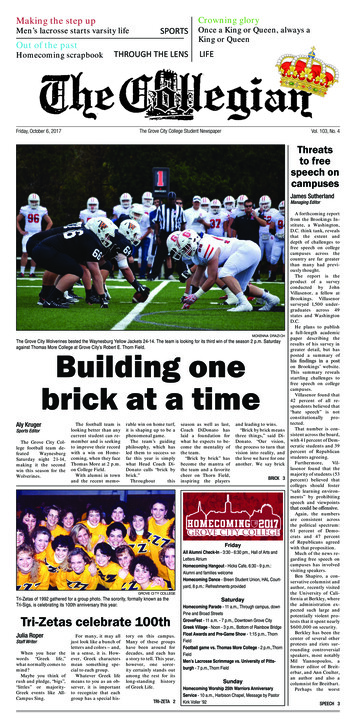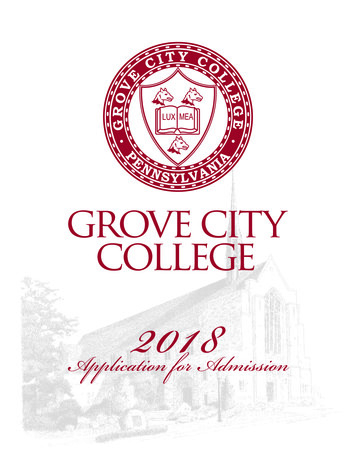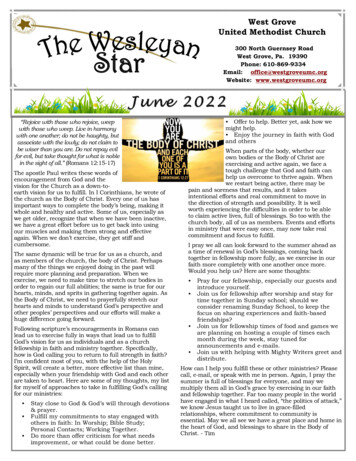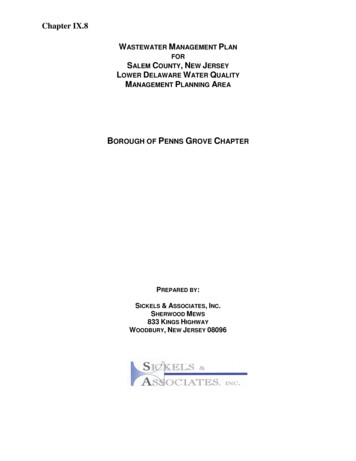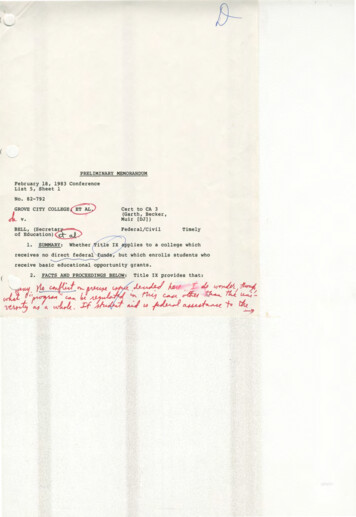
Transcription
(PRELIMINARY MEMORANDUMFebruary 18, 1983 ConferenceList 5, Sheet 1No. 82-792lGROVE CITYCOLLEGE v.BELL, (Secretar of Education) 1.SUMMARY:Cert to CA 3(Garth, Becker,Muir [OJ])Federal/CivilWhetherreceives no direct federal Timelyplies to a college whichwhich enrolls students whoreceive basic educational opportunity grants.2.FACTS AND PROCEEDINGS BELOW:Title IX provides that:
- 2 (No person in the United States shall, on thebasis of sex, be excluded from participation in,be denied the benefits of, or be subjected todiscrimination under any education program oractivity receiving Federal financial assistance."20 u.s.c. s 1681.20 U.S.C. S 1682 authorizes the termination of federal funds toany program that does not comply with S 1681.Department of Education regulations require each recipientof federal financial aid to file an Assurance of Compliance, inwhich it agrees to comply, the the extent applicable to it, withTitle IX.In 1976, the Department of Education began efforts to securean Assurance from petr Grove. Grove refused to execute theAssurance, asserting that it received no federal financial ssistance.After a hearing, the department terminated grantsAnd loans to students attending Grove.Grove brought this action, together with four of itsstudents who received federal grants, seeking a declaration thatthe department's termination was void, and an injunctionprohibiting the department from requiring Grove to file anAssurance of Compliance as a condition of preserving itseligibility for the grant and loan programs.vThe DC granted petrs' motion for summary judgment.The DCheld that Title IX authorizes a termination of grants only uponan actual finding of sex discrimination, a finding which thedepartment had not made.It also held that the department wasbarred by the Due Process Clause from terminating the grants(·ithout first affording hearings to all students who would be
- 3 - tdversely affected.On appeal and cross-appeal, the court ofre erse .appealsThe ;held that federal student aid made Grove a recipientof federal financiala sistancewithin the meaning of Title IX.It relied on the language of the statute, the legislativehistory, and case law under1964.Tit eVI of the Civil Rights Act ofThe CA rejected petrs' argument that, since federalstudent aid is not earmarked for any specific educationalactivity, applying Title IX to this case would necessarily beinconsistent with the "program-specific" nature of Title IX.TheCA stated, in dictum, that when the federal government furnishesnon-earmarked aid to an institution, the institution as a wholeis the "program" receiving federal financial assistance.'-!Cker,con urringJudgein the judgment, declined to adopt the dicta.The CA also rejected petrs' argument that enforcement ofTitle IX would infringe upon the First Amendment rights of it andits students, holding that Congress has the power to imposereasonable conditions upon grants of federal financialassistance. Finally, the CA rejected the DC's conclusions thatassistance could be terminated only upon a finding of actualdiscrimination, and that the department could terminate thegrants without affording hearings to affected students, citing orthHaven Board of Education v. Bell,and O'Bannon v. Town Court Nursing Center,3.(CONTENTIONS:u.s.(1982),447 u.s. 773 (1980).Petrs contend this case presents a simpleissue: did Congress intend to subject to institution-wide Title regulation an independent college which refuses any federal
-4 -assistance, but which enrolls students who receive basiceducational opportunity grants directly from the government.This decision conflicts with North Haven Board of Education v.u.s.Bell,(1982) and with decisions of other CAs.Congress did not intend that a college which does not operate anyprogram or activity receiving federal financial assistance, andwhose only connection to federal aid is its admission of studentswho receive federal grants, would be subject to Title IXregulation.In North Haven, this Court rejected the CA2'sassertion that the regulatory authority of the Department ofEducation under Title IX was institution-wide.{"[A]n agency'sauthority under Title IX both to promulgate regulations and toterminate funds is subject to th J 1program specific limitatiori' of"§1681, 1682.-102 S.Ct. at 1926.--- ---------The CA3 disregarded this'-.-holding and held instead that any federal aid to studentsattending an educational institution would subject the wholeinstitution to Title IX regulation.Petrs contend the decision below also conflicts with Rice v.President and Fellows of Harvard College, 663 F.2d 336 (CAl1981), which rejected the arguments accepted below and held thatTitle IX applies only to the specific program receiving federalfinancial assistance.Petrs also contend the decision belowconflicts with University of Richmond v. Bell, 543 F.Sup. 321(Ed. Va. 1982), which the department has refused to appeal.There, the court held that Title IX did not apply to a private(university's athletic program where the only types of federalsistance received by the university were general students
- 5 -1ssistance and a 1,900 library grant.Petrs also contend thereis a conflict with theCA 5's interpretation of identicalprogramatic language under Title VI in Board of PublicInstruction of Taylor County, Florida v.Fin h,414 F.2d 1068,1077 (CA 5 1969).Petrs contend that the department's approach would have beenadopted in the initial version of Title IX introduced by SenatorBayh.However, Congress rejected this approach and adopted aprogram specific statute.Regulation is permissible in thoseprograms receiving federal aid, but is impermissible where aprogram receives no assistance.Congress did not intend thatassistance given directly to students without intervention orselection by the educational institution would subject the entire{ stitution to control.Because student assistance programs areso wide spread, to find otherwise would nullify Title IX'sprogram-specific directive for virtually every educationalinstitution in the country.-----The SG contends that petrs' argument is with the dictarejected by Judge Becker, and not with the judgment below.Theactual holding below is that Grove must file the Assurance ofCompliance required by the Title IX regulations because it is arecipient of federal financial assistance within the meaning ofTitle IX by virtue of its participation in the Basic EducationalOpportunity Grant Program.This holding does not conflict with rl/1. .-0any decision of this Court or of any other CA.(The decisionbelow is consistent with Hillsdale College v. HEW, No. 80-3207A 6 December 16, 1982), which held that Hillsdale College, \
- 6 -which receives no federal financial aid except through itsparticipation in student aid programs, is a recipient of federalfinancial assistance within the meaing of Title IX.The onlyrequirement at issue in this case is that the institution executean Assurance of Compliance.The department believes thatAssurances of Compliance are written and construed so as not toapply automatically to an institution as a whole.The apply onlyto those programs and activities of an institution that receivefederal financial assistance.No court has held that thedepartment may not require such an Assurance ."-- -The SG concedes that the dicta to which petrs object may]conflict with this Court's decision in North Haven, and doconflict with the decisions of several other CAs.(ot, however, present the conflict.This case doesSince this case was decided,the CA 3 has decided Haffer v. Temple University, 688 F.2d 14(1982), which applied the dicta from this case in a holding.Theresulting conflict among the CAs is to the proper interpretationof program specificity is, however, not presented in this case.[Haffer was decided on September 7, 1982.It appears that nocert. petn was filed.]The SG contends, finally, that petrs' First Amendmentargument is entirely without merit for the reasons stated by theCA, and that the issue listed as a question presented, but notdiscussed in the body of the petition, whether the department mayterminate assistance because of a refusal to execute an Assurance(of Compliance, rather than because of a finding of actual
- 7 1iscrimination, does not merit review because there is noconflict.4.DISCUSSION:The SG is correct that the statements ofthe CA challenged by petrs in the body of the petn are dicta. Ifthe SG's representations concerning the meaning of an Assuranceof Compliance are correct, the judgment in this case does notpresent any question worthy of review here.It is notunreasonable to ask institutions to comply with Title IX in anyprogram they run that receives federal financial assistance.Isuspect that this interpretation of Assurances of Complianceoriginated in the current administration, but do not doubt thatit is accurate as of now.The Court should wait for a case thatsquarely presents the issue on which there is a conflict.!Commend denial.' There is a response.2/2/83JBJaffeOp in petn.I
MEMORANDUMebruary 18, 1983- List 5, Sheet 1onference /.-//No. 82-792Cert to CA 3(Garth, Becker,Muir [DJ])GROVE CITY COLLEGE, ET AL.v.Federal/CivilBELL, (Secretaryof Education)TimelyThe program specific issue is raised in No. 82-862,Consolidated Rail Corp. v. LeStrange, Feb. 18 conference, List. 3,Sheet 2.The pool memo in that case recommends considering thesecases together and possibly granting on the program specif i cissue in Grove.For the reasons stated in my pool memo ln ;;rqve,I do not believe that case should be granted. tJishesIf the Co::r t.to resolve the conflict on program-specificity, H .:- · , l' 1. d;ant on that issue in LeStrange. February 9, 1983.o.:s- ."'/ ,. , L. ,N.s2.-111.z.fY\.,,Jaffe
Court . .'Voted on . , 19 . .Argued . , 19 . .Assigned . , 19 . . .Submitted . , 19 . . .Announced . , 19 . .No.82-792GROVEHOLDCERT.MERITSFORREVBurger, Ch. J . .Brennan, J . .White, J . ./. . .Marshall, J. . . . . . . . . . . . . . . . .Blackmun, J . /.Powell, J . .Rehnquist, J . ./Stevens, J . .O'Connor, J . .-AFFMOTIONGDABSENTN OT VOTI NG
Columbia University in the City of New YorkNew York, N.Y. 10027COLUMBIA LAW REVIEW435 West 116th StreetJuly 11, 1983The Honorable Lewis F. PowellSupreme Court of the United StatesWashington, DC 20543Dear Justice Powell:I have enclosed a copy of the final page proofs of TheProgram-Specific Reach of Title IX, a student Note that will appearin our June 1983 issue. The Note may be of some interest to you inconnection with Grove City College v. Bell.Sincerely,Christopher D. CerfEditor-in-ChiefCDC:bd-.,,7-12
NOTES The Program-Specific Reach of Title IXAt midnight on June 30, 1982 the ratification period for the proposedEqual Rights Amendment expired. 1 Opponents of the amendment had arguedthat equal rights for women could best be achieved on a statutory basis, andthat amending the Constitution was unnecessary .2 Moreover, existing statuteswere viewed as sufficiently protective of women's rights. One of the mostsignificant of these statutes is title IX of the Education Amendments of 1972, 3which prohibits sex discrimination in "any education program or a.:tivityreceiving federal financial assistance. " 4The courts have failed to develop a coherent interpretation of title IX'sreach into schools 5 receiving federal aid. Nowhere is the conflict in the caselaw more pronounced than on the question of whether a school's receipt ofstudent-aid funds triggers title IX coverage. Recently, the District Court forthe Eastern District of Virginia, in University of Richmond v. Re/1, 11 interpreted title IX's scope narrowly and held that the receipt of such funds doesnot bring a school within title IX's reach. 7 The Justice Department decidednot to appeal the decision; it found the district court judge's interpretationirrefutable." Nevertheless, three days after the Justice Department decided notto appeal, the Third Circuit held in favor of the government in Grove CityI . Sec G. Gunther, Cases and Material!. on Constitutional Law 157 (Supp . 1982). OnJanuary 3, t983 the Equal Rights Amendment was again introduced into Congre, . H.R.J. Rc!t .I, 98th Cong ., 1st Sess., 129 Cong. Rcc. 1146 (daily ed. Jan. 3, 1983).2. See Reagan's Women, New Republic, Oct. 28, 1981, at 6.3. 20 u.s.c . §§ 1681 - 1685 (1976).4. Section 90l(a) provides that : "No person in the United States shall, on the ba is of sex, beexcluded from participation in, be denied the benefits of, or be 'ubjcctcd to discrimination underany education program or activity receiving federal financial as\i' tancc . . . " 20 U .S.C.1681(a) (1976) . Section 901 also exempts several types of educational entities from title IXcoverage . I d. § 1681 (a)( I )-(9). Section 902 authorizes federal administrative enforcement of the §901 prohibition . ld. § 1682. Sec infra note 63. Judicial review of agency action can be obtainedunder § 903 . ld . § 1683. Section 904, id. § 1684, prohibits discrimination on the grounds ofblindness or visual impairment, and under § 905, id. § 1685, any program or activity whosefederal support is extended through contracts of insurance or guaranty is excluded from title IXcoverage.5. The term "school," as used in this Note, refers to an educational entity that controls itsown budget. Thus, a college, an entire university and a public school district can be "schools."This concept is meant to be distinguished from the statutory term "institution," which defines thescope of several of the exemptions in section 90l(a) . Sec 20 U.S.C. § 1681(c) (1'.176); 117 Cong.Rec. 39,262 (1971) (statement of Rep. Dellenback).6. 543 F. Supp. 321 (E.D. Va. 1982).7. ld. at 333.8. See N.Y. Times, Sept. 9, 1982, at A20, col. 3. But sec Letter from Clarence Pendleton,Chairman of the United States Commission on Civil Rights, to Terrel Bell, Secretary of Education(August 10, 1982) (expressing concern that the acceptance of the University of Richmond court'stheories would "decimate civil rights protection in education") (on file at the offices of theColumbia Law Review).*1210·'-·
REACH OF TITLE IX1211College v. Be/1. 9 There, the court gave title IX an expansive reach, holdingthat the college's receipt of student-aid funds did trigger title IX coverage ofthe entire college. 10 The Third Circuit's analysis explicitly took issue with theinterpretation of the University of Richmond court. 11 f-inally, only fourmonths after Grove City College v. Bell was decided, the Sixth Circuit answered this question in a third way. In Hillsdale College v. IIEW, 12 the courtheld that the receipt of student-aid funds leads to title IX coverage, but onlyof part of the school. 13 The Supreme Court has granted certiorari in GroveCity College v. Bell to resolve this confusion. 11This Note suggests a new approach to title IX. The Note first analyzes theconflicting case law interpreting "program or activity receiving Federal finan cial assistance." Before proposing a definition of "program or activity receiving Federal financial assistance," the Note explores the scope of the Deparl ment's authority to enforce title IX. A hitherto unrecognized distinctionemerges between the scope of the Department's authority to terminate federalaid and the scope of its authority to effectuate title IX by other means.Drawing on this distinction and on title IX's statutory language and legislativehistory, the Note then concludes that the term "program or activity receivingFederal financial assistance" should be defined as that portion of a schoolactually supported by a specific grant statute's funds. Finally, the Note outlines how this interpretation should be applied to I hree types of grant statutefunding: categorical aid, nonearmarked aid, and student aid.I. THE CONTROVERSY CONCERNING THE REACH OF TITLE IXSoon after Congress enacted title IX eleven years ago, a sharp controdeveloped concerning the extent of its reach into schools receivingfederal aid. The controversy erupted when the Department 111 proposed regula-versy1 9. 687 F .2d 684 (3d Cir. 1982), cert. granted, 103 S. Ct. 1181 (19X3) (Nn. H2-792) .10. ld. at 700.II. ld. ::11700 n.27.12. 696 F.2d 418 (6th Cir. 1982).13. ld. at 430.14. 103 S. Ct. 1181 {1983) (82- 792).15 . The controversy has frequently focused on whether title IX covers athletics. The focu onathletics stems from the political clout of those associated with intercollegiate athletics. Sec SexDiscrimination Regulations: Hearings Before the Subcomm. on l'o u,econdary Educ . of theHouse Comm. on Educ. and Labor, 94th Cong., l!.t s ss. 184 (1975) (statement of Rep.Buchanan) [hereinafter cited as Sex Discrimination Regulations Hearings]. In addition, blatant ex discrimination nourishes in educational athletics. ld. at 77-7'1. (statement of Kathy Kelly,President, U.S. National Student Association).16. In 1980, title IX enforcement authority was tran\fcrred to the newly created Departmcmof Education by§ 30l(a)(3) of the Department of Educ;uion Organilation Art. Pub. 1. No. 9688,93 Stat. 677,678 (1979) (codified at 20 U.S.C. § 3441 (Supp. V 19!!1)). Thi Note will usc thcterm "the Dcpartmcnt" to refer to both the Department of l ducatinn and IIEW. The lattercontrolled federal funds for education prior to 1980 and wrote the regulations effectuating titleIX .
1212COLUMBIA LAW REVIEW!Vol. R3: 1210017tions to effectuate the statute. The courts have reached divergent results as tothe scope of the statute's coverage.'HTitle IX prohibits sex discrimination in "any education program or acti vity receiving Federal financial assistance." 111 The controversy concerns thecongressional intent underlying this statutory language. 20 Last term, the Supreme Court, in North Haven Board of Education v. Be/1, 21 concluded thattitle IX's reach is limited by its program-speci fie language- its programspecificity. 22 In other words, title IX prohibits only discrimination occurringwithin a federally funded "program or activity." The Court distinguishedprogram -specificity from what this Note terms the strict institutional approach.2J Under the latter, if a school receives any type of federal aid, theentire school is automatically covered by title IX. The Court indicated that thestrict institutional approach was inconsistent with the language and legi lativchistory of the statute. 24 Nonetheless the Court expressly declined to determinethe exact meaning of program-spccificity. 2 " The bound(lrics of title IX's reachtherefore remain unclear. 211t7 . 40 Fed . Reg. 24,121! (1975) (codified at 34 C.F.R. § 106 (191!1)). Sec generally SexDiscrimination Regulations Hearings, supra note 15, at 1- 2 (describing the purpo c of thehearings as a review of the regulations); Comment, HEW's Regulation Under Title IX of theEducation Amendments of 1972: Ultra Vires Challenges, 1976 B. Y .U. L. Rev. 133 ( 1976) (arguingthat the regulations exceed the Department's statutory authority) )herein a ftcr cttcJ as Comment.Ultra Vires].18. Sec infra notes 27-61 and accompanying text. Compare Othen v. Ann Arbor Schoollld . ,507 f . Supp. 1376 (E .D. Mich. 1981) (construing the reach of title IX narrowly), aff'd on othergrounds, 699 F .2d 309 (6th Cir. 1983), with Haffer v. Temple Univ., 524 F. Supp . 531 (E.D . Pa .1981) (construing the reach of title IX expansively), atTd, 688 F.2d 14 (3d Cir . 1982).19 . 20 U .S.C. § 168l(a) (1976) . for the full text of title IX's prohibition, sec supra note 4 .20. The prindpal aim of statutory interpretation is a ccrtaining and cffe tuating the legisla tive intent. Philbrook v. Glodgett, 421 U.S. 707, 713 (1975). Sec generally Kernochan, StatutoryInterpretation: An Outline of Method, 3 Dalhousie L.J. 333, 344 (1976).21. 456 u.s. 512 (1982).22. Id. at 537.23. I d. Proponents of an expansive intcrprclation of title IX have argued tlwt Iitle IX b.:;tpplicd on the basis of thi' strkt inslitntional approach . Sec, e.g., Othcn v. Ann Arbor Sd10ollid., 507 F. Supp . 1376, 13KO (E. D. Mkh. 19!11) (plaintiff a'scrted strict institutional approa h),aff'd on other grounJs, 699 F.2d 309 (6th Cir. 19!!3); d . Yakin v. University of Illinois, 508 F.Supp. 848, 850 (N . D. Ill. 1981) (strict institutional approach followed in enfordng title Vlof th( Civil Rights Act of 1964).24. North !Iaven Bd. of Educ. v. Bell, 456 U.S. 512,536- 38 (1982).25. ld.at 1927.26. The lower court interpretations of program-specificity after North 1/uven conflict. Secsupra note 18 (examples of pre-North Haven conflict). Compare Hillsdale College v. HEW, 696F.2d 418 (6th Cir. 1982).(construing the reach of Iitle IX narrowly), with Grove City College v.Bell, 687 F.2d 684 (3d Cir. 1982) (construing the reach of title IX broadly in the same situation),cert. granted, 103 S. Ct. 1181 (1983) (No. 82-792). While the majority of the courts addressing theissue have construed title IX's re:Kh narrowly, sec infra notes 27 - 45 and accompanying text, somecourts have interpreted the stalute broadly, see infra notes 46- 60 and accompanying text.
1983]REACH OF TITLE IX1213A. Cases Interpreting Title IX's Reach NarrowlyThe decisions construing program-specificity narrowly 27 can be seen asreflecting the rejection of the strict institutional approach. Any broad readingof program-specificity is perceived as merely an attempt to evade the statute'sexpress program-specific approach. 2HThese decisions assume that "program or activity" is defined from theperspective of the educational institution. 211 Under this view, educational insti tutions consist of many "programs," such as "athletic programs," :lo "workstudy programs,'' 31 and "math department programs,''J 2 which exist irrespective of the school's receipt of federal aid. Relying on this definition of"program or activity," these courts have held that Congress meant for title IXto apply only to those discrete parts of a school receiving aid, rather than to27 . Sec, e.g. , Hillsdale College v. HEW, 696 F.2d 418 (6th Cir. 1982); Rice v. l'rc' tdent utHarvard College, 663 F.2d 336 (1st Cir. 1981), ccrt. denied, 456 U.S . 928 (19H2); Univcr.,ity ofRichmond v. Bell, 543 f. Supp. 321 (E . D. Va. 1982); Othcn v. Ann Arbor School Ild., 507 F.Supp. 1376 (E.D . Mich. 1981), aff'd on other grounds, 699 F.2d 309 (6th Cir. 1983) .The major proponents of this narrow interpretation have, of course, been school officiab orthose affiliated with educational institutions. See Sex Discrimination Regulation Hearing.,, supranote 15, at !JR- 99 (statement of John Fuzak, President, National Collegiate Athletic A' ' nciation);id . at 228 - 30 ( tatcmcnt of Dr. Dallin Oaks, President, Brigham Young University and Dircnorand Secretary of the American Association of Presidents of Independent Colleges and Universi ties) .The majority of the commentators who have addrcs.,ed the issue have argued for a narrowreading of title IX . Kuhn, Title IX: Employment and Athletics arc Outside HEW's Jurisdiction,65 Geo . L.J . 48,62- 64 (1976); Comment, Ultra Vires, supra note 17, at 181 - 82; Note, Title IXSex Discrimination Regulations: Impact on Private Education, 65 Ky. L.J. 656, 694 (1 )77)[hereinafter cited as Note, Title IX Impact]; Note, Title VI, Title IX, and the Private University:Defining "Recipient" and "Program or Part Thereof," 78 Mich. L. Rev. 608 (1980) [hereinaftercited as Note, Title VI, Title IX). This commentary primarily addresses the question of whetherthe title IX regulations arc valid agency rulemaking to effectuate congressional intent concerningtitle IX. Published before the courts began to interpret title IX's swpc, the commentary has hadan important impact on the analysis of several courts . Sec, e.g., Othcn v. Ann Arbor School Ild.,507 F . Supp. 1376, 1388 (E.D . Mich . 1981), aff'd on other grounds, 699 F.2d 309 (6th Cir . 1983).28. See, e.g . , Hillsdale College v. HEW, 696 F.2d 418, 430 (6th Cir . 1982); University ofRichmond v. Bell, 543 F. Supp. 321, 330(E.D. Va. 1982); Comment, Ultra Vires, supra note 17,at 182-84.29. See, e.g., Hillsdale College v. HEW, 696 F.2d 418, 424-30 (6th Cir. 1982); Ucnnctt v.West Texas State Univ., 525 F. Supp. 77,79 (N . D. Tex. 1981); Othcn v. Ann Arbor School Ild.,507 F. Supp . 1376, 1382 (E. D. Mich. 1981), aff'd on other grounds, 699 F.2d 309 (6th Cir. 1983).30. Sec Othcn v. Ann Arbor School Bd . , 507 F. Supp . 1376, 1378 (E . D. Mich . 1981), aff'don other gounds, 699 F.2d 309 (6th Cir . 1983).31. See Rice v. President of Harvard College, 663 F.2d 336, 33R (1st Cir . 1981), ccrt. denied,456 u.s. 928 (1982) .32. Sec Hillsdale College v. HEW, 696 f.2d 418, 428 (6th Cir. 1982). Commentators havecome to similar conclusions concerning the definition of "program or activity." Sec, e .g., Kuhn,supra note 27, at 62-64; Note, Title VI, Title IX, supra note 27, at 623; Comment, Title IX of the1972 Education Amcndrncnts: Preventing Sex Discrimination In Public Schools, 53 Tex. L. Rev.103, 110 (1974) !hereinafter cited as Comment, Public Srhoob]. But cf. Note, AdministrativeCutoff of Federal Funding Under Title VI: A Proposed Definition of "Program," 52 Ind . I.J .651, 669 (1977) (arguing that "program" should be given a flexible definition that depends onhow the aid is used by the recipient).
1214COLUMBIA LA IV Rl:.'V/l:.' W!Vol. X3: 12 10()the entire school.n They have applied what this Note terms the direct -fundin ginterpretation of title IX; only those parts of a school that receive federal aiddirectly are covered by title IX's prohibition. For example, the Sixth Circ uitrecently held that although the school's receipt of student -aid funds did triggertitle IX coverage, only the school's "student grant and loan program "" 1 wascovered. The court stated that[t]here is no explicit language in Title IX which supports HEW' sposition that an entire institution can constitute an "education program or activity." . . As noted by one commentator, the term"program" was used in the Congressional debates preceding passage of Title IX "to refer not to the total program of an educationalinstitution but to smaller-scale activities within the institution." . .In short, we find that the legislative history of . . . l'i t le I Xreveal[s] no indication that Congress contemplated that an ent ireeducational institution could constitute a single "program or activ ity." We further find that the position of HEW is incon s i tent withthe program-speci fie nature of Title IX insofar as its practi cal effectwould be to circumvent the programmatic focus of the statute andadopt the institutional approach. :1"Similarly, several courts applying the direct-funding interpretation have con cluded that receipt of noncarmarked aid fails to trigger title IX coveragebecause it docs not constitute aid to a specific "program or activity.":l 11The direct-funding interpretation seems to have been derived in large partby equating the reach of title IX's prohibition with the scope of the Department's authority to terminate a school's federal aid.:17 Title IX expressly limits33. See, e.g., Othen v. Ann Arbor School Bd., 507 F . Supp . 1376. 1388 (E . D. Mkh . 19tH),aff'd on other grounds, 699 F.2d 309 (6th Cir . 1983). The Otilen court noted that the Senateoriginally acted on a version of title IX that was clearly institutional in scope, but later passed thepresent version of title IX . ld. at t382; sec infra note 131 and accompanying text. The court alsonoted that§ 904 of title IX, 20 U.S.C. § 1684 (1976), in contrast to§ 901, contains an explicitinstitutional prohibition on admissions discrimination against the blind and vi ually handicapped.Othen v. Ann Arbor School Lid., 507 F. Supp. 1376, 1382 (E . D. Mich . 19RI), aff ' d on othergrounds, 699 f'.2d 309 (6th Cir . 19SJ). See infra notes 196- 205 and accompanying text; e al soHillsdale College v. HEW, 696 F .2d 418, 426- 27 (6th Cir. 1982) (conduding that intcrprctiug"program" as the entire school is inconsistent with congressional intent) .34 . Hillsdale College v. HEW, 696 F.2d 418, 430 (lith Cir. 1982) .35 . ld. at 427; sec also University of Richmond v. Bell, 543 1:. Supp. 321, 332 -J3 (E. D. Va .1982) ("athletic program" received no direct federal funding but was funded, in part, from thegeneral budget of the scho ol that included federal student aid; held, title IX did not cover theathl etic department) . The Reagan Administration's interpretation of program-specificity closelyparallels that articulated by the Sixth Circuit in 1/i//sda/e. See U.S. Dep't of Justice, Civil RightsDivision, Memorandum on Program -Specificity 2 (March 15, 1983) (on file at the offices of theColumbia Law Review) )hereinafter cited as Memorandum).36. Sec University of Richmond v. Bell, 543 F. Supp. 321, 332 (E.D. Ya. 1982); Othen v.Ann Arbor Sdwollld., 507 F. Supp. 1376, 1389 (E.D. Mich . 19!!1), afT'd on other ground!., 6'J9F.2d J09 (6th Cir. 19R3).37 . The Department has relied on its uuthority to terminate a school's federal aid a' its chidmeans of enforcing wmpliancc with title IX's prohibition . Sec Comment. Ultra Vires, supra note17, at 178 n.210.
',1983]REACH OF TITLE IXI 15the latter by stating that "termination . sh all be limited in its effec t to theparticular program, or part thereof, in which such noncompliance has been sofound." :IH This language is often referred to as the "pinpoint provisi o n." ·'''Some courts have read the pinpoint provision as diclatin g that only those partsof a school whose funds can be terminated arc covered by title lX's proh ibition. 40Several courts have implicitly equated the reach or title IX' s prohibitionwith the scope of the pinpoint provision even when the title IX prohibitionwas being enforced by other mcans. 41 The district court decision in Otlren
GROVE CITY COLLEGE, ET AL. v. MEMORANDUM Cert to CA 3 (Garth, Becker, Muir [DJ]) BELL, (Secretary of Education) Federal/Civil Timely The program specific issue is raised in No. 82-862, Consolidated Rail Corp. v. LeStrange, Feb. 18 conference, List. 3, Sheet 2. The pool memo in that case recommends considering these .
